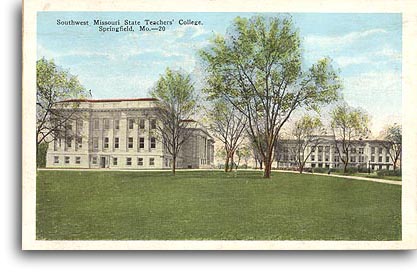HISTORICAL POSTCARDS OF SPRINGFIELD, MISSOURI
Southwest Missouri State Teachers' College
 This postcard shows a view from National Avenue looking east at two of the Southwest Missouri State Teachers' College buildings. The building facing the viewer is what is currently Carrington Hall but was originally called Academic Hall. It was built in 1908 of Phenix stone. In 1945 the name was changed to the Administration Building.
This postcard shows a view from National Avenue looking east at two of the Southwest Missouri State Teachers' College buildings. The building facing the viewer is what is currently Carrington Hall but was originally called Academic Hall. It was built in 1908 of Phenix stone. In 1945 the name was changed to the Administration Building.
The building on the left side of the postcard is now called Hill Hall. It was built in 1923 and called the Education Building. Before it was built, a two-room frame structure called McCortney Hall sat on the site. The new Education Building was designed by architect Earl Hawkins and used Carthage stone similar to that used in building the Academic Hall. It was built to hold the laboratory school, that had been spread among several buildings up to this time. It was functionally designed by Southwest Missouri State College president Clyde M. Hill, SMSC's second president. He was originally from West Plains and headed the Yale University Education Department for many years. According to Dr. Roy Ellis, few college buildings in America have been as widely copied as Hill Hall. The building was designed to house 390 students, 30 to a grade, from kindergarten through high school.
For a number of years each college graduating class had a name of someone famous in the field of education carved on the frieze of the Education Building. Among the famous names carved are Copernicus, Carrington, Plato and Greenwood.
In 1965 a new Greenwood Laboratory School was built to house the elementary through high school students. The original Education Building was then converted to college classroom use and offices.
Postcards Home | Keyword Search | Local History Home